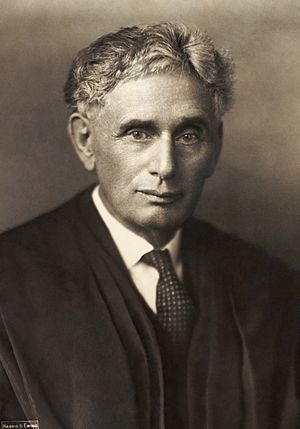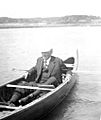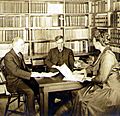Louis Brandeis facts for kids
Quick facts for kids
Louis Brandeis
|
|
|---|---|
 |
|
| Associate Justice of the Supreme Court of the United States | |
| In office June 1, 1916 – February 13, 1939 |
|
| Nominated by | Woodrow Wilson |
| Preceded by | Joseph Lamar |
| Succeeded by | William O. Douglas |
| Personal details | |
| Born |
Louis David Brandeis
November 13, 1856 Louisville, Kentucky, U.S. |
| Died | October 5, 1941 (aged 84) Washington, D.C., U.S. |
| Political party | Republican (before 1912) Democratic (after 1912) |
| Spouse |
Alice Goldmark
(m. 1891) |
| Children | 2 |
| Education | Harvard University (LLB) |
Louis Dembitz Brandeis (November 13, 1856 – October 5, 1941) was an important American lawyer. He later became an associate justice on the Supreme Court of the United States. This is the highest court in the country. He served there from 1916 to 1939.
Brandeis was born in Louisville, Kentucky. His parents were immigrants from Bohemia, which is now part of the Czech Republic. They raised him in a home that respected Jewish culture but was not strictly religious. He went to Harvard Law School. He graduated at age 20 with the best grades in the school's history.
After law school, Brandeis moved to Boston. He started a law firm there that is still active today. He became well-known for working on social causes. These causes aimed to improve society and people's lives.
Brandeis helped create the idea of the "right to privacy" in 1890. He wrote an article about it for the Harvard Law Review. A famous legal expert, Roscoe Pound, said Brandeis "added a chapter to our law." This means his ideas greatly changed how privacy was understood.
He also wrote a book called Other People's Money and How the Bankers Use It. In this book, he suggested ways to control the power of big banks. He believed these banks had too much influence. Brandeis fought against large companies, monopolies (when one company controls everything), and public corruption. He felt these things hurt American values. He also joined the Zionist movement. This movement supported a Jewish homeland. He saw it as a way to fight antisemitism (prejudice against Jewish people) and "revive the Jewish spirit."
Contents
The People's Lawyer
Once his family was financially secure, Brandeis spent most of his time on public causes. People started calling him the "People's Lawyer." He often worked on cases without pay. This allowed him to focus on bigger issues, not just making money. The Economist magazine even called him "A Robin Hood of the law." This meant he helped ordinary people against powerful groups.
Key Legal Battles
Some of his early important cases involved fighting railroad monopolies. These were situations where one railroad company controlled all transportation. He also defended laws that protected workers and their rights. He helped create the Federal Reserve System. This system manages the nation's money and banks. He also shared ideas for the new Federal Trade Commission. This agency works to prevent unfair business practices.
Brandeis became famous for a special type of legal document called the "Brandeis Brief." This brief used information from experts in other fields, not just legal experts. For example, he might use facts from doctors or economists. This new way of presenting evidence changed how cases were argued in court.
Joining the Supreme Court
In 1916, President Woodrow Wilson chose Brandeis to join the Supreme Court. His nomination was very controversial. Many people opposed him. Justice William O. Douglas later wrote that Brandeis was a "militant crusader for social justice." He was seen as dangerous because he was brilliant, brave, and could not be corrupted. He was also the first Jewish person to be named to the Court. This made some powerful people even more worried.
On June 1, 1916, the Senate voted 47 to 22 to confirm him. He became one of the most famous and important figures on the Supreme Court. Legal experts say his opinions were some of the best defenses of freedom of speech and the right to privacy ever written by a Supreme Court Justice.
Later Life and Legacy
Brandeis retired from the Supreme Court on February 13, 1939. He passed away on October 5, 1941, after a heart attack.
Both Justice Brandeis and his wife are buried at the University of Louisville's Brandeis School of Law. Brandeis himself made arrangements for this. His professional papers are kept at the law school's library.
Institutions Named After Brandeis
Many places and organizations are named in honor of Louis Brandeis.
- Brandeis University, in Waltham, Massachusetts. This is a well-known university.
- The University of Louisville's Louis D. Brandeis School of Law. This law school was named after him in 1997.
- Kibbutz Ein Hashofet in Israel. "Ein Hashofet" means "Spring of the Judge" in Hebrew. This name honors Brandeis's support for Zionism.
- Kfar Brandeis is a suburb in the Israeli city of Hadera.
- The Louis D. Brandeis Center for Human Rights under Law. This group works to fight antisemitism in colleges and universities.
Images for kids
-
Time cover, 19 Oct 1925
-
The Louis D. Brandeis School of Law at the University of Louisville opened in 1846 and was named for Justice Brandeis in 1997.
See also
 In Spanish: Louis Brandeis para niños
In Spanish: Louis Brandeis para niños










